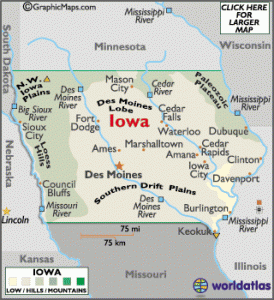Iowa
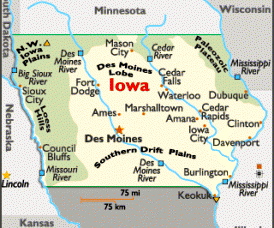
Important People in Iowa History
- (1673) French explorers, Jolliet and Marquette explored the area for the King of France
- (1682) LaSalle explored Mississippi River, claimed the river and land for King of France
1700’s
- (1762) King of France transferred claim to the land to the King of Spain during Seven Years’ War
- (1788) Julien Dubuque became first white settler in Iowa
1800’s
 (1800) Spain transferred land back to France during Napoleonic Wars in Europe
(1800) Spain transferred land back to France during Napoleonic Wars in Europe- (1803) United States acquired Iowa in Louisiana Purchase
- (1804) Lewis and Clark expedition arrived; only death on the expedition occurred
- (1808) U.S. Army built Fort Madison
- (1811) New Madrid fault caused earthquakes in central Iowa
- (1813) Troops abandoned and burned Fort Madison
- (1820) Missouri Compromise made Iowa non-slave territory
- (1832) Black Hawk War ended; Sauk tribe forced to cede land west of Mississippi River
- (1833) Iowa Territory opened for settlement
- (1834) Patrick O’Connor first person hung in Iowa
- (1846) Nearly 20,000 Mormons crossed Iowa; Iowa admitted to Union as 29th state
- (1847) Dutch immigrants arrived at Pella
- (1856) First train from Chicago arrived Iowa City; band of Sioux indians massacred settlers at Spirit Lake
- (1857) State capital moved to Des Moines from Iowa City
- (1858) First legislative session held in Des Moines
- (1867) Grasshopper invasion occurred, crops damaged; first railroad completed through Iowa
- (1890) Huge meteor struck ground 11 miles northwest of Forest City
- (1893) Pomeroy tornado struck Calhoun County, destroyed 80% of homes, killed 71 and injured 200
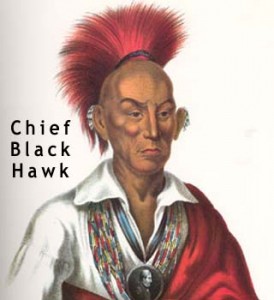 Although Native Americans have occupied what is now Iowa for 13,000 years, the written history of Iowa begins with the protohistoric accounts of Native Americans by explorers such as Marquette and Joliet in the 1680s. Until the early 19th century Iowa was occupied exclusively by Indians and a few European traders, with loose political control by France and Spain. Iowa became part of the United States of America after the Louisiana Purchase in 1803, but uncontested U.S. control over what is now Iowa occurred only after the War of 1812 and after a series of treaties eliminated Indians claims on the state. Beginning in the 1830s American settlements appeared in the Iowa Territory, U.S. statehood was acquired in 1846, and by 1860 almost the entire state was settled and farmed. Subsistence frontier farming was replaced by commodity farming after the construction of railroad networks in the 1850s and 1860s. Iowa contributed a disproportionate amount of young men to fight in the American Civil War, afterwards they returned to help transform Iowa into an agricultural powerhouse, supplying food to the rest of the nation. The industrialization of agriculture and the emergence of centralized commodities markets in the late 19th century and 20th centuries led to a shift towards larger farms and the decline of the small family farm, this was exacerbated during the Great Depression. Industrial production became a larger part of the economy during World War II and the postwar economic boom. In the 1970s and 1980s a series of economic shocks, including the oil crisis, the 1980’s farm crisis, and the Early 1980’s recession led to the collapse of commodities prices, a decline in rural and state population, and rural flight. Iowa’s economy rebounded in the 1990s, emerging as a modern mixed economy dominated by industry, commerce, finance and in which agriculture is a comparatively small component. Iowa’s population is now predominately urban and has been increasing since the 1990s at a faster rate than the U.S. as a whole, although rural flight continues to be a problem.
Although Native Americans have occupied what is now Iowa for 13,000 years, the written history of Iowa begins with the protohistoric accounts of Native Americans by explorers such as Marquette and Joliet in the 1680s. Until the early 19th century Iowa was occupied exclusively by Indians and a few European traders, with loose political control by France and Spain. Iowa became part of the United States of America after the Louisiana Purchase in 1803, but uncontested U.S. control over what is now Iowa occurred only after the War of 1812 and after a series of treaties eliminated Indians claims on the state. Beginning in the 1830s American settlements appeared in the Iowa Territory, U.S. statehood was acquired in 1846, and by 1860 almost the entire state was settled and farmed. Subsistence frontier farming was replaced by commodity farming after the construction of railroad networks in the 1850s and 1860s. Iowa contributed a disproportionate amount of young men to fight in the American Civil War, afterwards they returned to help transform Iowa into an agricultural powerhouse, supplying food to the rest of the nation. The industrialization of agriculture and the emergence of centralized commodities markets in the late 19th century and 20th centuries led to a shift towards larger farms and the decline of the small family farm, this was exacerbated during the Great Depression. Industrial production became a larger part of the economy during World War II and the postwar economic boom. In the 1970s and 1980s a series of economic shocks, including the oil crisis, the 1980’s farm crisis, and the Early 1980’s recession led to the collapse of commodities prices, a decline in rural and state population, and rural flight. Iowa’s economy rebounded in the 1990s, emerging as a modern mixed economy dominated by industry, commerce, finance and in which agriculture is a comparatively small component. Iowa’s population is now predominately urban and has been increasing since the 1990s at a faster rate than the U.S. as a whole, although rural flight continues to be a problem.
Prehistory
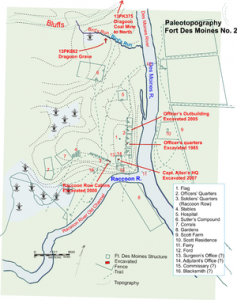 Map of prehistoric and historic Indian sites in Downtown Des Moines
Map of prehistoric and historic Indian sites in Downtown Des Moines
Main article: Iowa archaeology
When the American Indians first arrived in what is now Iowa more than 13,000 years ago, they were hunters and gatherers living in a Pleistocene glacial landscape. By the time European explorers visited Iowa, American Indians were largely settled farmers with complex economic, social, and political systems. This transformation happened gradually. During the Archaic period (10,500-2,800 years ago), American Indians adapted to local environments and ecosystems, slowly becoming more sedentary as populations increased. More than 3,000 years ago, during the Late Archaic period, American Indians in Iowa began utilizing domesticated plants. The subsequent Woodland period saw an increase on the reliance on agriculture and social complexity, with increased use of mounds, ceramics, and specialized subsistence. During the Late Prehistoric period (beginning about A.D. 900) increased use of maize and social changes led to social flourishing and nucleated settlements. The arrival of European trade goods and diseases in the Protohistoric period led to dramatic population shifts and economic and social upheaval, with the arrival of new tribes and early European explorers and traders.
Early Historic American Indians – Main article: Indians of Iowa
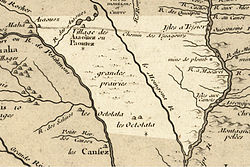 1718 Guillaume Delisle map, showing locations of the Ioway (Aiouez au Pauotez), the Omaha (Maha), the Otoe (Octotata), the Kaw (Cansez) and the main voyageur trail (Chemin des voyageurs).
1718 Guillaume Delisle map, showing locations of the Ioway (Aiouez au Pauotez), the Omaha (Maha), the Otoe (Octotata), the Kaw (Cansez) and the main voyageur trail (Chemin des voyageurs).
Before 1673, the region had long been home to many American Indians. Approximately seventeen different American Indian tribes had resided here at various times including the Ioway, Sauk, Meskwaki (called Fox in many sources), Sioux, Potawatomi, Oto, and Missouri.
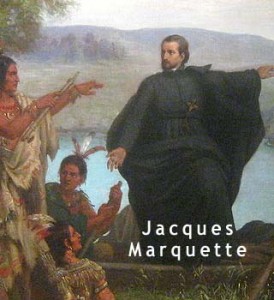 In 1673 the Frenchmen J. Marquette and L. Joliet visited Iowa. The French then considered the region to be part of their American possession ‘Louisiana’, or ‘New France’. In the Treaty of Paris (1763), the French ceded Louisiana to Spain; in the secret Third Treaty of San Ildefonso (1800), the Spanish returned Louisiana to France; in 1803 the French sold Louisiana to the United States. The Potawatomi, Oto, and Missouri Indians had sold their land to the U.S. federal government by 1830 while the Sauk and Meskwaki remained in the Iowa region until 1845. The Santee Band of the Sioux was the last to negotiate a treaty with the federal government in 1851.
In 1673 the Frenchmen J. Marquette and L. Joliet visited Iowa. The French then considered the region to be part of their American possession ‘Louisiana’, or ‘New France’. In the Treaty of Paris (1763), the French ceded Louisiana to Spain; in the secret Third Treaty of San Ildefonso (1800), the Spanish returned Louisiana to France; in 1803 the French sold Louisiana to the United States. The Potawatomi, Oto, and Missouri Indians had sold their land to the U.S. federal government by 1830 while the Sauk and Meskwaki remained in the Iowa region until 1845. The Santee Band of the Sioux was the last to negotiate a treaty with the federal government in 1851.
 Fort Madison (1808-1813), the scene of Iowa’s only military battle.
Fort Madison (1808-1813), the scene of Iowa’s only military battle.
The Sauk and Meskwaki constituted the largest and most powerful tribes in the Upper Mississippi Valley. They had earlier moved from the Michigan region into Wisconsin and by the 1730s, they had relocated in western Illinois. There they established their villages along the Rock and Mississippi Rivers. They lived in their main villages only for a few months each year. At other times, they traveled throughout western Illinois and eastern Iowa hunting, fishing, and gathering food and materials with which to make domestic articles. Every spring, the two tribes traveled northward into Minnesota where they tapped mapletrees and made syrup. Fort Madison was constructed in 1808 to control trade along the Mississippi, and to prevent the reoccupation of the area by the British; Fort Madison was defeated in 1813 by British-allied Indians during the War of 1812 and was the site of Iowa’s only true military battle. The Sauk leader Black Hawk first fought against the U.S. at Fort Madison.
 Iowa, 1798, showing several tribes, including Pawnee (Panis/Panibousa), Ioway(Aiaouez/Aioureoua and Paoute/Paoutaoua),
Iowa, 1798, showing several tribes, including Pawnee (Panis/Panibousa), Ioway(Aiaouez/Aioureoua and Paoute/Paoutaoua),
Dakota (Sioux), and Omhaha (Maha); approximate state highlighted.
In 1829, the federal government informed the two tribes that they must leave their villages in western Illinois and move across the Mississippi River into the Iowa region. The federal government claimed ownership of the Illinois land as a result of Quashquame‘s Treaty of 1804. The move was made but not without violence. Black Hawk, a highly respected Sauk leader, protested the move and in 1832 returned to reclaim the Illinois village of Saukenuk. For the next three months, the Illinois militia pursued Black Hawk and his band of approximately four hundred Indians northward along the eastern side of the Mississippi River. The Indians surrendered at the Bad Axe River in Wisconsin, their numbers having dwindled to about two hundred. This encounter is known as the Black Hawk War. As punishment for their resistance, the federal government required the Sauk and Meskwaki to relinquish some of their land in eastern Iowa. This land, known as the Black Hawk Purchase, constituted a strip fifty miles wide lying along the Mississippi River, stretching from the Missouri border to approximately Fayette and Clayton Counties in Northeastern Iowa.
Today, Iowa is still home to one American Indian group, the Meskwaki, who reside on the Meskwaki Settlement in Tama County. After most Sauk and Meskwaki members had been removed from the state, some Meskwaki tribal members, along with a few Sauk, returned to hunt and fish in eastern Iowa. The Indians then approached Governor James Grimes with the request that they be allowed to purchase back some of their original land. They collected $735 for their first land purchase and eventually they bought back approximately 3,200 acres (13 km²). After purchasing some of their land back, the Iowa Legislature fought for the Meskwaki tribe to receive an annual payment from the Federal Government. This took ten years to be resolved.
Iowa’s first American settlers
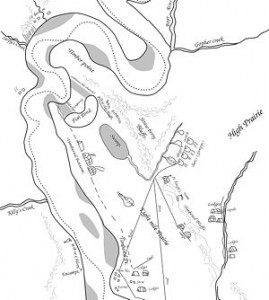 Pierre-Jean De Smet‘s map of the Council Bluffs, Iowaarea (1839), showing Native American villages and early American settlement.
Pierre-Jean De Smet‘s map of the Council Bluffs, Iowaarea (1839), showing Native American villages and early American settlement.
The first official American settlement in Iowa began in June 1833, in the Black Hawk Purchase. Most of Iowa’s early settlers came from Ohio, Pennsylvania, New York, Indiana, Kentucky, and Virginia. The great majority of newcomers came in family units. Most families had resided in at least one additional state between the time they left their state of birth and the time they arrived in Iowa. Sometimes families had relocated three or four times before they reached Iowa. At the same time, not all settlers remained here; many soon moved on to the Dakotas or other areas in the Great Plains.
The settlers soon discovered an environment different from that which they had known back East. Most northeastern and southeastern states were heavily timbered; settlers there had material for building homes, outbuildings, and fences. Moreover, wood also provided ample fuel. Once past the extreme eastern portion of Iowa, settlers quickly discovered that the state was primarily a prairie or tall grass region. Trees grew abundantly in the extreme eastern and southeastern portions, and along rivers and streams, but elsewhere timber was limited.
In most portions of eastern and central Iowa, settlers could find sufficient timber for construction of log cabins, but substitute materials had to be found for fuel and fencing. For fuel, they turned to dried prairie hay, corn cobs, and dried animal droppings. In southern Iowa, early settlers found coal outcroppings along rivers and streams. People moving into northwest Iowa, an area also devoid of trees, constructed sod houses. Some of the early sod house residents wrote in glowing terms about their new quarters, insisting that “soddies” were not only cheap to build but were warm in the winter and cool in the summer. They did not praise the bugs, the smells, or the ever-present dirt, dampness and darkness.
Settlers experimented endlessly with substitute fencing materials. Some residents built stone fences; some constructed dirt ridges; others dug ditches. The most successful fencing material was the osage orange hedge until the 1870s when the invention of barbed wire provided farmers with satisfactory fencing material.
Transportation: railroad fever
As thousands of settlers poured into Iowa in the mid-19th century, all shared a common concern for the development of adequate transportation. The earliest settlers shipped their agricultural goods down the Mississippi River to New Orleans, Louisiana, but by the 1850s, Iowans had caught the nation’s railroad fever. The nation’s first railroad had been built near Baltimore in 1831, and by 1860, Chicago, Illinois was served by almost a dozen lines. Iowans, like other Midwesterners, were anxious to start railroad building in their state.
In the early 1850s, city officials in the river communities of Dubuque, Clinton, Davenport, and Burlington began to organize local railroad companies. City officials knew that railroads building west from Chicago would soon reach the Mississippi River opposite the four Iowa cities. With the 1850s, railroad planning took place which eventually resulted in the development of the Illinois Central, the Chicago and North Western Railway, reaching Council Bluffs in 1867. Council Bluffs had been designated as the eastern terminus for the Union Pacific, the railroad that would eventually extend across the western half of the nation and along with the Central Pacific, provide the nation’s First Transcontinental Railroad. A short time later a fifth railroad, the Chicago, Milwaukee, St. Paul and Pacific Railroad, also completed its line across the state.
The completion of five railroads across Iowa brought major economic changes. Of primary importance, Iowans could travel every month of the year. During the later 19th and early 20th centuries, even small Iowa towns had six passenger trains a day. Steamboatsand stagecoaches had previously provided transportation, but both were highly dependent on the weather, and steam boats could not travel at all once the rivers had frozen over. Railroads also provided year-round transportation for Iowa’s farmers. With Chicago‘s pre-eminence as a railroad center, the corn, wheat, beef, and pork raised by Iowa’s farmers could be shipped through Chicago, across the nation to eastern seaports, and from there, anywhere in the world.
Railroads also brought major changes in Iowa’s industrial sector. Before 1870, Iowa contained some manufacturing firms in the eastern portion of the state, particularly all made possible by year-around railroad transportation. Many of the new industries were related to agriculture. In Cedar Rapids, John and Robert Stuart, along with their cousin, George Douglas, started an oats processing plant. In time, this firm took the name Quaker Oats. Meat packing plants also appeared in the 1870s in different parts of the state: Sinclair Meat Packing opened in Cedar Rapids, Booge and Company started in Sioux City, and John Morrell & Company set up operations in Ottumwa.
The railroads also created a significant demand for coal. Coal mines were quickly opened and expanded wherever the new railroads passed through areas with coal exposures. The Chicago and North Western Railway encouraged development of mines in Boone and Moingona. The Chicago, Milwaukee and St. Paul Railway encouraged similar deveopment in Mystic, Iowa and neighboring coal camps. Where railroads did not have direct access to sufficient coal, long branch lines were built into the coal fields. The Burlington, Cedar Rapids and Northern Railway built a 66 mile branch to What Cheer in 1879, and the Chicago and North Western built a 64 mile branch to its mines in Muchakinock in 1884. By 1899, Iowa’s coal mines employed 11,029 men to produce almost 5 million tons of coal per year. In 1919, Iowa had about 240 coal mines that between them produced over 8 million tons of coal per year and employed about 15,000 men.
The Civil War
Iowa became a state on December 28, 1846 (the 29th state), and the state continued to attract many settlers, both native and foreign-born. Only the extreme northwestern part of the state remained a frontier area.
Iowa supported the Union during the American Civil War, voting heavily for Lincoln and the Republicans, though there was a strong antiwar “Copperhead” movement among settlers of southern origins and among Catholics. There were no battles in the state, but Iowa sent large supplies of food to the armies and the eastern cities. More than 75,000 Iowa men served, many in combat units attached to the western armies. 13,001 died of wounds or (two-thirds) of disease. Eight thousand five hundred Iowa men were wounded. The draft was not used in Iowa during the Civil War because Iowa had twelve thousand more men than the quota.

